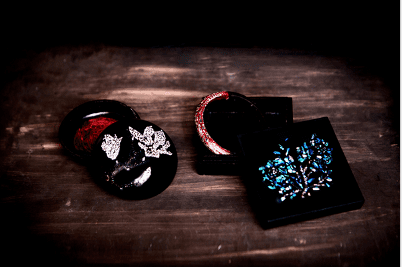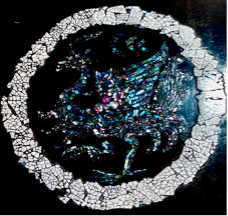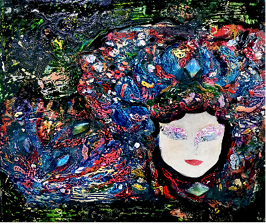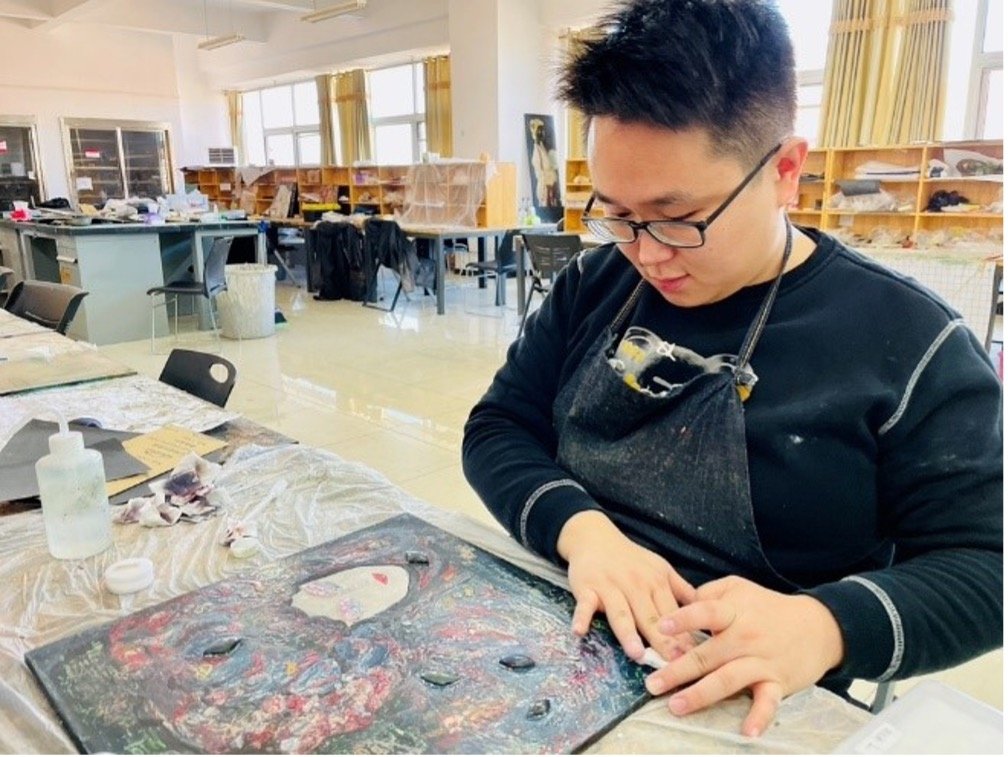Author: Junhaoran Li (Oliver) – Edited by Nataša Aster-Stater

Before studying arts and crafts, Oliver wasn’t aware of what lacquerware was – though his home had items made through the lacquer technique, he was unaware of it due to my lack of knowledge. After studying, Oliver became deeply captivated by this ancient craft.
Origins of Lacquer Art Form:
Lacquer art is an ancient art form that originated in China and has a history spanning over 3,000 years. This craft utilizes the natural sap extracted from the lacquer tree—known as raw lacquer—to coat various objects, giving them a hard, shiny, and durable surface.
Raw lacquer gradually hardens after exposure to wet air (humidity between 60% and 80%), forming a protective layer. In ancient times, lacquer was extensively used to produce furniture, tableware, Buddha statues, and other decorative items.
Beyond China, lacquer art also proliferated and evolved in regions like Japan, Korea, and other parts of Southeast Asia. Each region developed its unique techniques and styles. For instance, Japan’s “Maki-e” technique involves inlaying mother-of-pearl fragments onto the lacquer surface, resulting in astonishing effects.
Crafting Lacquer:
Lacquer art is more than just applying lacquer – It encompasses various intricate techniques such as inlaying, carving, filigree, and gold and silver outlining. Moreover, crafting lacquerware demands immense time and patience as each layer of lacquer requires ample time to dry, and a single piece might entail dozens or even hundreds of layers.
This venerable art form continues to be cherished and admired in contemporary times, reflecting a harmonious blend of handcraftsmanship and traditional aesthetics.
The malleability of lacquer is so strong that it can be combined with any material. As a result, he can engage in endless exploration, a characteristic that deeply fascinates him.
Opposite to other Art Mediums:
Meanwhile, other art mediums, such as watercolour and acrylic paint, dry by losing moisture; Lacquer art requires drying in the humid air. This opposite drying process also seems very interesting.
Also, in the inlay process, the most common materials are natural, like eggshells and seashells – all these aspects allow Oliver to explore the therapeutic nature of materials, which is very relevant to his current studies in art therapy. This serendipitous coincidence has made him even more passionate about this art form.
In conclusion, these lacquerware pieces can provide an exciting insight into this enchanting art form – and a delve deeper into lacquer art is wondrous.
Description of Artworks:
- Cinnabar Box, Jewelry Box, and Bracelets (2022):

Oliver crafted rouge boxes, jewellery boxes, and bracelets using lacquer craft on wooden structures, inspired by the Chinese folk tale of Mulan.
These items, once essential for ancient Chinese women, reflect Mulan’s transition from warrior to feminine identity – Orchids and magnolia patterns on the jewellery and rouge boxes symbolize Mulan’s essence.
Despite her heroic feats on the battlefield, Mulan’s heart remained true to her feminine nature, embodying strength, and grace in both realms – much like artwork.
2. Flinders Street Station in Melbourne (40*40cm,2021):

Flinders Station, Australia’s inaugural train station, holds a special place OIiver’s memory from his 2019 visit on a Working Holiday Visa (WHV) to Melbourne. Immersed in lacquer painting studies, he captured the essence of this landmark through intricate inlay techniques.
Utilizing mother-of-pearl and eggshell, my artwork vividly portrays the iconic scene.
This piece serves as a homage to the memorable moments he experienced while traversing the vibrant streets of Melbourne and stands as a testament to the fusion of my travels with my artistic endeavours.
3. Mythical Creature Vermilion Phoenix(20*20cm,2021):

Oliver’s debut lacquer painting draws inspiration from a Han Dynasty artifact – the Vermilion Bird from the Four Sacred Beasts’ roof tiles.
These tiles, called “Wadang”, adorned ancient Chinese roofs, offering protection against evil.
The Vermilion Bird, representing the south and flames, symbolizes his birthplace in China, and by utilizing turquoise shells to depict the traditional red Vermilion Bird, he aimed for a distinctive effect.
This unconventional approach highlights its significance akin to the Western Phoenix. His artwork merges cultural symbolism with personal identity, echoing the timeless tales of protection and renewal across diverse traditions.
4. Portrait of Peking Opera(40*40cm,2021):

Oliver’s inaugural portrait in lacquer painting depicts a character from the renowned Peking Opera, employing a technique blending wood powder and crushed eggshell to replicate human skin.
Peking Opera, a celebrated traditional Chinese art form, is distinguished by its elaborate facial makeup, symbolizing diverse character traits.
Using lacquer painting, he captured the dramatic essence of this theatrical tradition, where actors don vibrant, exaggerated makeup for heightened expression.
This piece reflects the complexity of the lacquer art form, incorporating various intricate techniques to convey the richness and depth of Peking Opera’s cultural significance – transcending linguistic barriers in its portrayal.
Contact: Instagram: @hikarioliver



